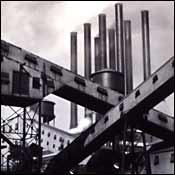
Whatever Marcel Duchamp touched, Charles Sheeler said, had a “most beautiful precision.” The same could be said of Sheeler himself. As both a photographer and a painter, Sheeler (1883–1965) aspired to a preternatural clarity; he let no blur or grime disturb his focus. In another era, he would have been a strict classicist; as a young man in the early years of the twentieth century, he found his characteristic imagery in the logic of industrial America—its machine dreams. Although Sheeler took more interest in painting than in photography, his photographs have arguably held up better over time, especially the ones he made in the twenties at the Ford plant in River Rouge near Detroit. But his greatest contribution to American culture is actually neither a painting nor a still photograph. In 1920, Sheeler collaborated with Paul Strand on a brief and miraculous film called Manhatta, a celebration of the city that is the star feature of The Photography of Charles Sheeler at the Metropolitan Museum of Art. Every New Yorker should see it.
The exhibition at the Met—organized by the Museum of Fine Arts, Boston—consists mainly of several series of photographs that Sheeler made between 1915 and 1939. During a trip to Europe in 1908–09, Sheeler confronted powerful modernist ideas; then, back in New York, he continued to follow the evolution of European modernism—particularly Cubism. He was attracted to that style’s abstracted compositions, classical reserve, and thoroughly modern air. Like many of his contemporaries in New York, he adapted European tools to the American grain. From 1915 to 1917, he found Cubistlike relationships and textures at a farm in Doylestown, Pennsylvania. If a quaint cottage could become a form of Cubism, so could a nude: His tightly cropped images of his wife, Katharine, taken about the same time, turn unruly flesh into carefully balanced abstract compositions.
In 1927, Sheeler photographed the Ford works at River Rouge, a massive plant that produced the Model A automobile. From the beginning of the modern era, people had argued about the character of “the machine.” Some found it dehumanizing; others, charged with possibility. Among artists who welcomed the machine age, the starry-eyed championed America’s move from the natural to the industrial “sublime” and called factories the cathedrals of the industrial age. Sheeler partook of this romance, but only up to a point. That’s the strength of his River Rouge photographs: They create an industrial icon without too much cosmic crapola or poetic pictorial fuzz. A factory is still a factory. And the camera remains a machine that makes images. Shouldn’t a camera bring something of its own character to the depiction of a machine? Doesn’t like know like? Even Criss-Crossed Conveyors, a picture in which powerful diagonals frame smokestacks that soar skyward, appears frank, plain, and mechanical. (There’s a great deal of practical engineering beneath those dreamy pillars.) When Sheeler went to Europe a couple of years later, he wittily turned the cliché about “cathedrals of industry” on its head by depicting Chartres—admired above all for its ethereal glass—as a marvel of engineering.
It’s hard to imagine Sheeler alone creating Manhatta, a work of modernist bliss that contains none of the artist’s customary reserve. Perhaps Paul Strand stretched Sheeler’s sensibility; perhaps, too, the “moving picture” stimulated Sheeler to yield to the smoke, steam, and ever-changing dynamism of Manhattan. The ten-minute film describes a day in the life of the city, opening with the Staten Island ferry disgorging commuters and ending with the setting sun illuminating the rivers, towers, and bays. Locomotives chug, workers operate machinery, tugboats push, cars dart. The skyscrapers create raking angles. The light pulses. The geometry never stops. Between scenes, Sheeler and Strand interpolate quotations from Walt Whitman’s Leaves of Grass: “When million-footed Manhattan unpent descends to her pavements … ” Manhattan itself becomes a living being, the embodiment of modern American energy. A New York museum should put this great early film, perhaps the most dramatic portrayal of the city in existence, on permanent display.
Art Listings
•Openings & Closings
•Museums
•Galleries
•Photography
•More